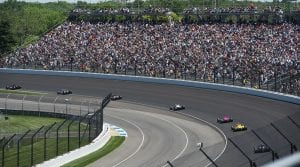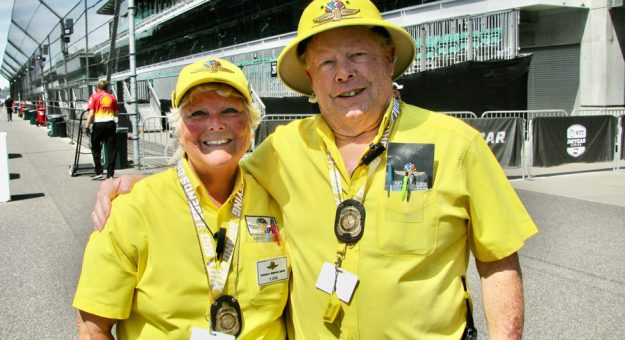INDIANAPOLIS — The Indianapolis Motor Speedway’s “Safety Patrol,” commonly known as “Yellow Shirts” due to their color of their shirts, are integral to the success of the Indianapolis 500 each year.
During the month of May and at other IMS events they can be seen parking cars, directing traffic, giving directions, overseeing grandstands, operating elevators, checking credentials and tickets, getting celebrities from point A to point B, helping to maintain order, and countless other tasks.
They are true ambassadors of not only the track but the entire sport, the state of Indiana and even the United States due to the Indy 500’s many foreign fans, and they strive to show true “Hoosier Hospitality” to all.
“This year we have hired and scheduled 675 Safety Patrol for the month of May,” said David Letherman, the IMS employee who runs the Safety Patrol. “The Yellow Shirts are bolstered by the IMS College Program, in which we have hired 160 college students who work in various locations around the track in operations, ticketing, credentials, client services, marketing and sustainability.”
Many people think Yellow Shirts are all volunteers, but they are paid, seasonal employees.
Being one can be fun, but it isn’t always easy.
Two people who know the job inside and out are Jacque and Bill Powers of Martinsville, Ind., who will retire after Sunday’s Indy 500 after 32 years of service as Yellow Shirts. They are both “gold badge” members of the Safety Patrol. Bill is the stand captain for the Pit Road Terrace grandstand, and Jacque is his assistant.
Both are retired from their regular jobs. Bill was a mechanical machine repairman for Rolls Royce, and Jacque spent 18 years as the in-school suspension supervisor at Martinsville High School. They were both race fans before they became Yellow Shirts in 1992, although Bill is quick to point out “Jacque more so than me.”
“As a child growing up, at least one Sunday in May we would leave church and go to IMS and watch the race cars, and then go over to Weir Cook Airport and watch the planes land,” Jacque recalls. “That was our May tradition.”
Bill was a drag racer for a while, and he still enjoys attending oval dirt tracks such as Paragon (Ind.) Speedway, which is near their home.
They became Yellow Shirts in a round-about way.
“While talking with a friend of ours one day, I said something about Danny Sullivan,” Jacque said. “Our friend told us he worked as a Yellow Shirt at the track, and one thing led to another and we became Yellow Shirts, too.”
Now 32 years later, they can look back at working a myriad of events.
“In the past we did everything except the air race,” Jacque said. “We worked the F-1 race, the Brickyard and the motorcycle race in addition to the 500. We also worked special events that are held at the track, like a hospital Christmas party, the Easter egg hunt, the Mutt Strut, the Mini Marathon and things like that.”
Getting to see drivers and other celebrities — and in some cases even becoming close friends — was a definite perk. They have lots of stories about both drivers and celebrities, and a house full of Indy car parts and other memorabilia.
But being a Yellow Shirt also entails long hours, standing for great lengths of time, very long walks, and being in the elements. Sunburn and leg cramps are the norm, not the exception. Sometimes they have to stand on black asphalt for hours, and the Indiana sun can be brutal.
So can rain.

“If it’s raining, we still have to be out front of the grandstands,” Jacque said. “When those aluminum stands are wet, they’re slick and the fans are usually coming down the stairs to get out of the rain. If somebody slips and gets hurt we have to fill out an incident report. The weather can vary a lot.
“We’ll go from getting sunburn to wearing a winter coat under your yellow shirt. The Grand Prix can be chilly and wet.
“We have to watch the crowd for signs of anyone suffering from heat stroke or from drinking too much,” she added. “We help them find what section their seats are in, because that can be confusing. We make sure they don’t have glass bottles, they don’t stand on the seats and there’s no smoking; that sort of thing. On race day we have to remind people to take their tickets with them if they leave their seats.”
The grandstands that the Powers oversee are temporary, and only brought in for the 500.
“There is never a section 32; it goes from 31 to 33,” Jacque said. “We have a group of regulars who come every day, every year and they have made their own section 32 sign that they hang up. Of course they take it down for race days, or other fans would be really confused trying to find their seat!”
There have definitely been challenges with some members of the public.
“One time four young kids got drunk and I had to take a lot of profanity,” Bill related. “I took it for as long as I could, and then I called on the radio for the police, and the police took them out.”
There’s an annual training session for the Yellow Shirts each year to provide guidance for working with the public and for potential situations and challenges.
“One of the things they stress is not to say, ‘I don’t know,’” Bill said. “We’re to make a phone call or use our radios and get an answer to whatever question comes up.”
People are both the best thing about the job and the worse thing about the job.
“We’ve met a lot of people — fans, team owners, sponsors, drivers, drivers’ wives, movie stars,” Jacque said. “Through being a Yellow Shirt we were able to join CARA Charities before it disbanded, and our son won one of the Rich Vogler scholarships.”
The couple also worked at various jobs at Chicagoland Speedway in both the pits and the garage, and they worked in Champ Car as pit observers. At one time they were responsible for making sure the cars’ pop-off valves were sealed, Bill ran the radar gun at a race in Cleveland to catch cars speeding on pit lane, and they collected tire temperatures on pit lane.
“Those were all things we got to do because we started out as a Yellow Shirt and just met different people,” Jacque said. “We have friendships made over the course of years with people whose names we don’t know. They know our names because of our nametags, but we don’t know theirs.”
“There’s Paul and Mike; one sits on one side of the handrail, and the other on the other side,” Bill said. “I know Paul’s name; it’s Paul Johnson. He’s been sitting there for 68 years, and for Mike it’s something like 50 years, but I don’t know Mike’s last name.”
“One guy has a seeing eye dog; he’s another regular,” Jacque said.
Names are a minor issue when the friendships are true.
When she learned one of the fans who sit in their section needed a kidney transplant, Jacque applied to become a donor.
“It was funny; I didn’t know his name to put on the application,” she said. “I did have their phone number, so I called his wife and got his name. That’s the kind of relationships we have with the people we’ve bonded with.”
She wasn’t a match, but the offer was definitely appreciated. What will they do for the 108th running of the Indy 500 in 2024?
“Jacque will be here every day she can, and I’ll come back for Pole Day and Carb Day, and we’ll probably drive to Kentucky to watch it live on TV if it’s blacked out on local TV,” Bill said. “On the days we’re at the track we’ll probably buy tickets in the Pit Road Terrace, because we’ve become friends with a lot of the people there.
“We’re both members of the Indianapolis 500 Old Timers too, so we’ll see people there that we know,” Jacque said.
“When we’re working, we’re paid to watch the people, not the race cars,” she added. “Now, it’ll be our turn to watch the race cars.”
